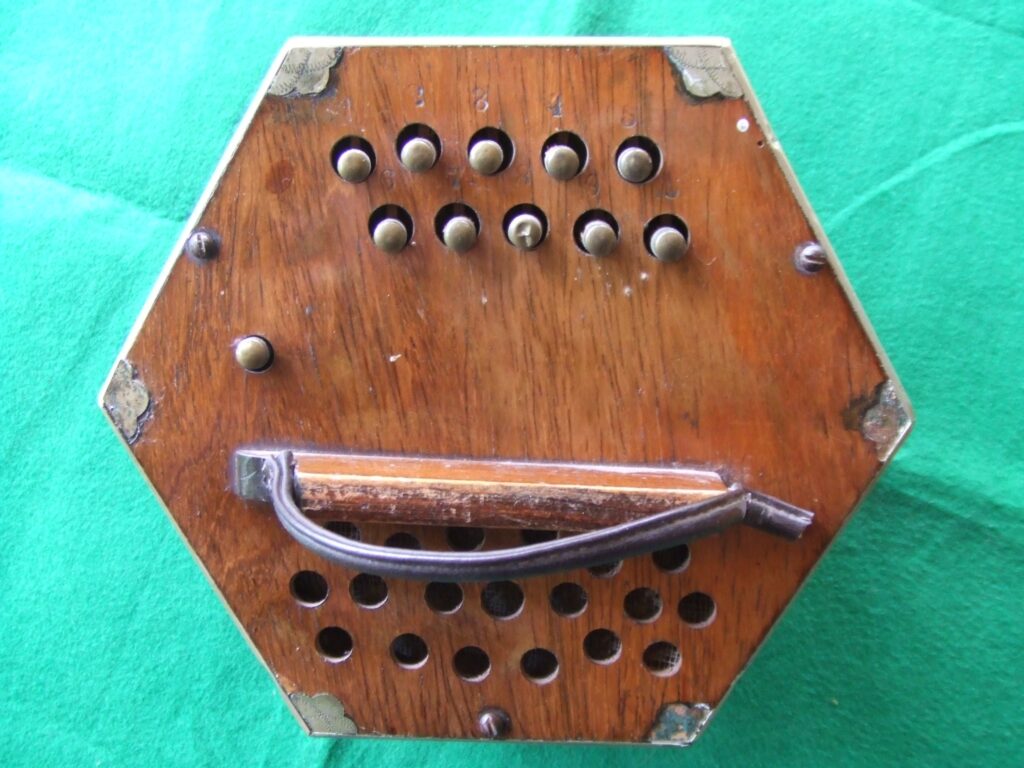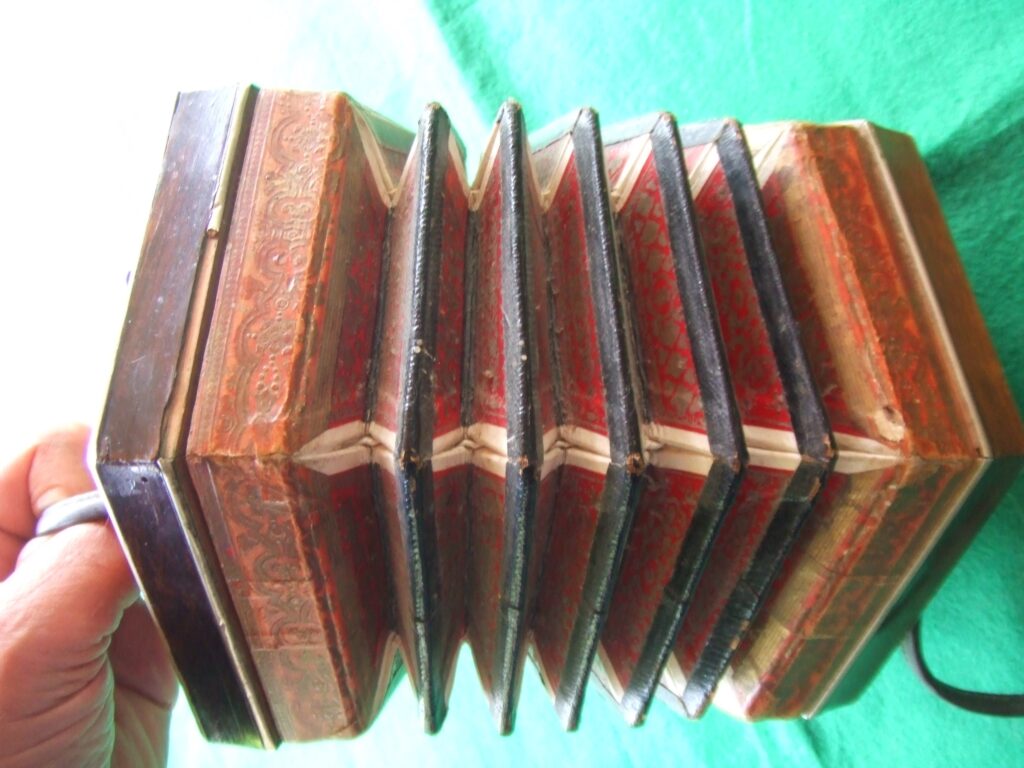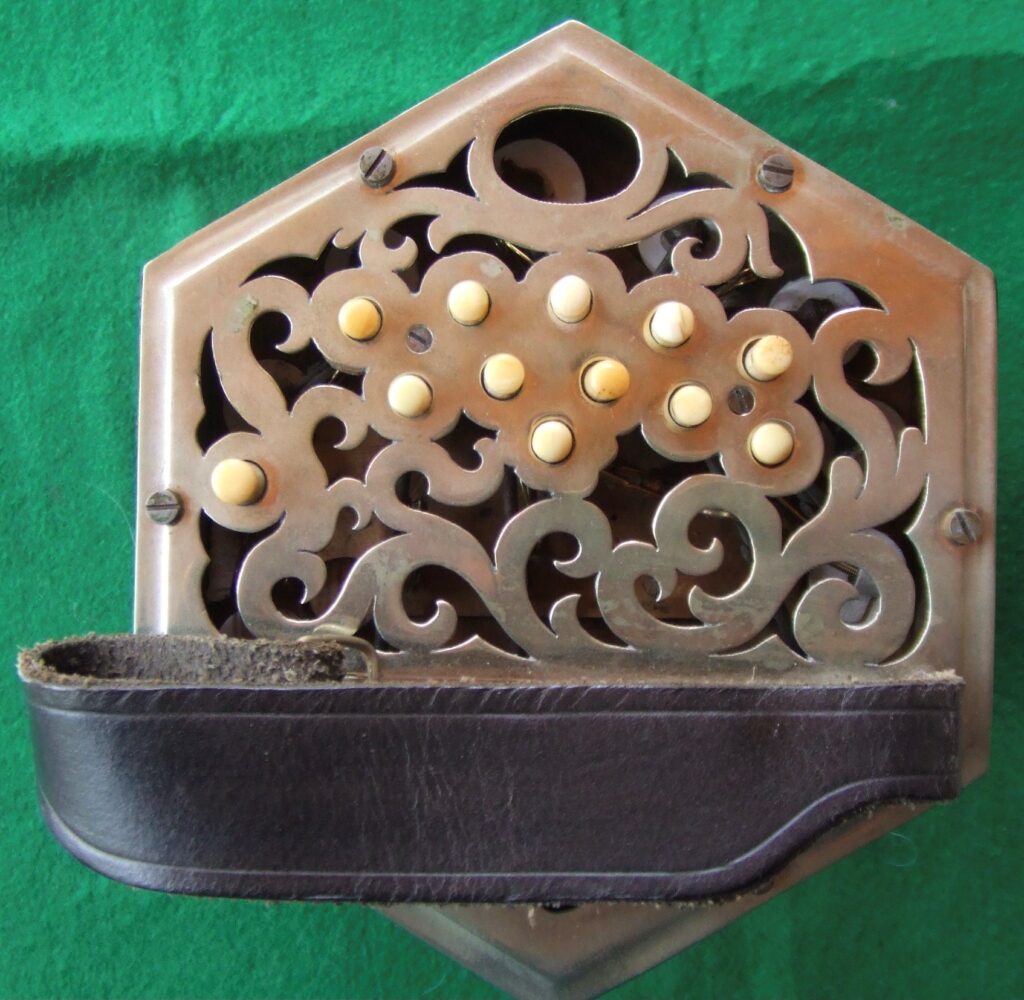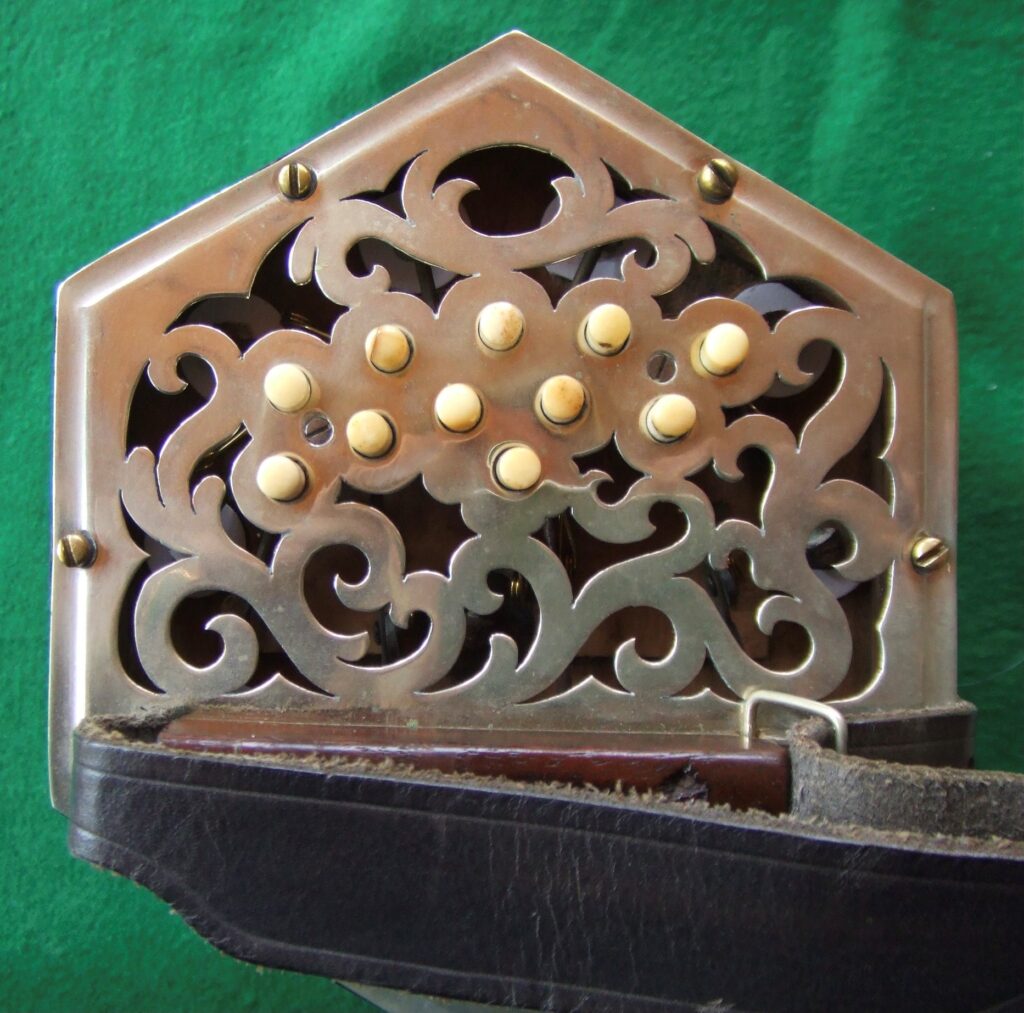By Roger Digby
When Charles Wheatstone, with his financial backers, his team of specialist, skilled craftsmen and his own professorial knowledge of acoustics, was creating his sophisticated concertina, other developments and ideas for free reed instruments were happening in Europe. This led to such instruments as the Aeolina and the Flutina. Most significant was to be the German Concertina. Originally rectangular and with ten buttons, five on each end, this instrument gave roughly three octaves in just one key. (If you think of a modern one-row melodeon with the ten buttons split over both ends, you’ll get the idea; indeed, there is good evidence that the German concertina was conceived in this very way.) The two reeds behind each button were tuned to different notes and thus the ten buttons gave twenty notes. It was very cheaply made with a wooden action, cloth and paper bellows and no reed chambers.
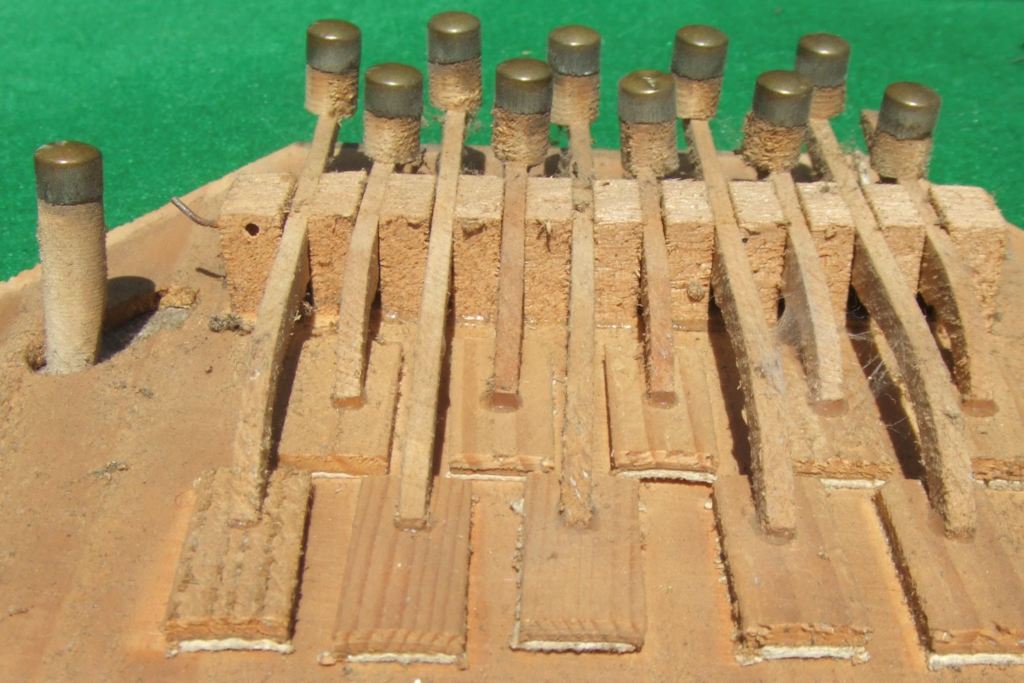
Fig. 1. The wooden action of an early German Concertina
The inventor of this instrument, Carl Uhlig (1794-1874) then added a second row of ten more buttons tuned a musical fifth higher than the existing row. This was configured in a way that was very similar to the existing row; a tune played in, say, C major on the first row could be played in G major on the second row using almost identical fingering. 2
This instrument was instantly and hugely successful, not just in Europe but throughout the UK and soon across the world. This may in part have been because it is easy to play by ear and simple harmonies create themselves effortlessly by staying on the rows. The main reason was certainly the cost. The instrument was very cheap and this was because it was very very cheaply made. There is vast documentary evidence for this widespread presence and Henry Mayhew 3 recorded a conversation with a lad who played one for a living on Thames pleasure boats. During this interview the lad said two things which are pertinent here. He said that the ‘instrument was very fashionable then, and everybody had it nearly.’ He also said that they needed constant repair and lasted him about three months. This explains why, despite their wide use in the second half of the twentieth century, so few are seen today; they broke and were thrown away. 4
Fig. 2. An early German Concertina
Wheatstone had no time at all for these cheap impostors, simply renaming his instrument, now in mass production, the ‘English Concertina’ to remove any confusion with the German upstart. By this time there were other manufacturers starting up and one of them had the idea of using the German layout and combining it with Wheatstone’s high standards of manufacture and acoustics. Two makers claimed to have done this. George Jones, a former Music Hall artist, who had a workshop in Whitechapel and John Crabb, first of the four generations of Crabb Concertinas, then in Clerkenwell. With the names ‘English Concertina’ and ‘German Concertina’ already taken a new name was required for a German style concertina made to English specifications – hence: ‘Anglo German Concertina’.
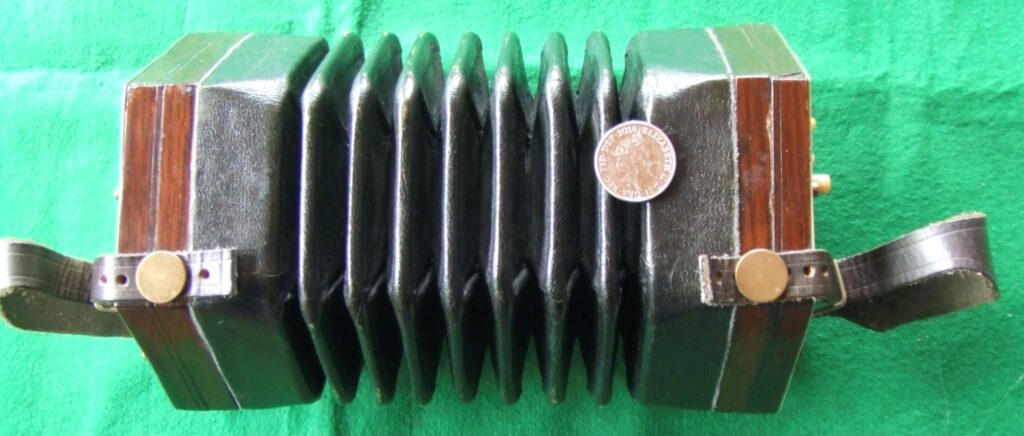
Fig. 3. A small scale, anonymous Anglo German Concertina. The extra button below the two rows on each side gives a duck quack and a bird tweet. Together with the small size, this suggests a novelty instrument for stage use
Jones then added a third row above the existing two which gave the extra notes needed to make the instrument fully chromatic in the middle of its range. This was the ‘Anglo Chromatic Concertina’. 5 Eventually, the commercial success of these instruments forced Wheatstone to enter the market. 6 More buttons were sometimes added to give more options and range. Thirty nine button instruments tended to come from Crabb and later Jeffries, forty buttons from Wheatstone. Sometimes instruments had even more, but the size of the reed pan only allowed these extra reeds to be very small giving very high notes and these were often shrill.
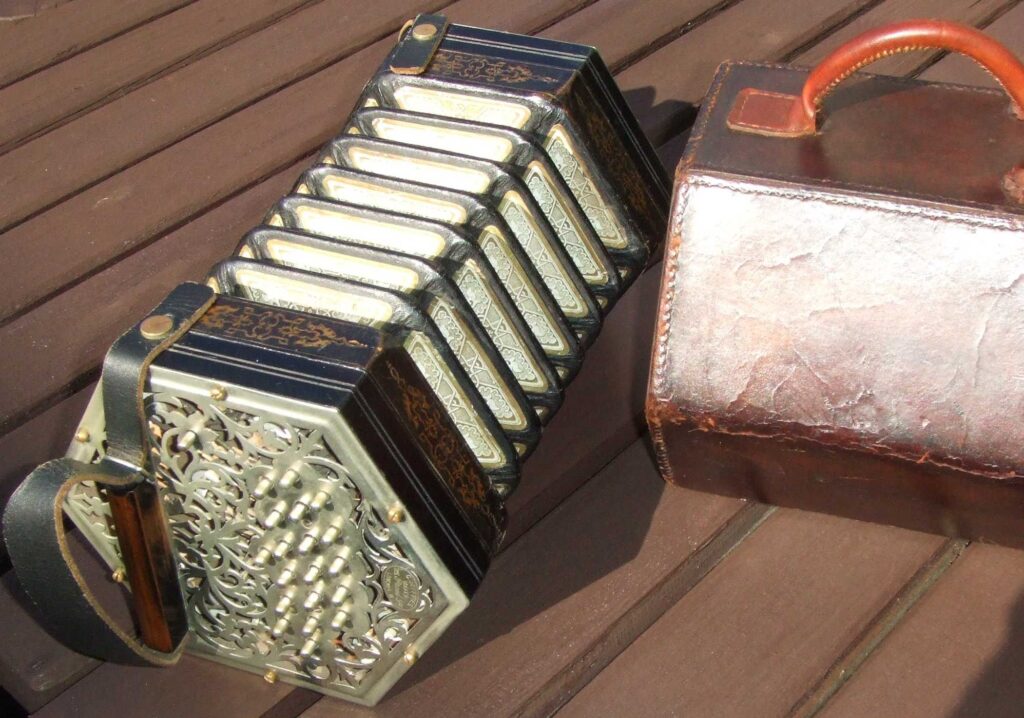
Fig.4. A 39 key Jeffries, Circa 1900
The majority of the references which provide the evidence for the widespread playing of the German Concertina occur in Victorian newspapers and are in an urban context; newspapers are by nature largely urban. Nevertheless there is sufficient evidence to show that the German Concertina was popular in the countryside and so would have joined the fiddle, flute, serpent, etc in the village music-making. The paucity of recordings of Traditional Music in the first half of the twentieth century in England is remarkable. Perhaps the recording companies simply didn’t know it existed, or perhaps they thought that those interested in the music didn’t have sufficient disposable income to make production viable.
In the 1970s when Keith Summers recorded widely in Suffolk, his recordings quickly finding a home at Topic Records,7 he found not a single concertina player and this was the case in the rest of the country too. So it is that we have only two examples of Traditional English Anglo players, William Kimber and Scan Tester. 8
Kimber 9 (1872-1961), was the musician for Headington Quarry Morris Men, with whom he also danced and a significant figure in the Folk Revival in the first half of the twentieth century. Today, when so much revival Cotswold Morris is danced to a confused and random assortment of musicians, it is easy to lose sight of the symbiotic nature of musician and dancers that occurs when a solo musician plays for dancers and dances that he (and at that time it always was ‘he’) knew well. Lionel Bacon 10 describes the Headington style as ‘brisk, lively….taken fast’ and that is exactly how Kimber played. He transferred this style to other country dance tunes that he played. Because of this close association with the dances and dance style of Headington Quarry his approach to Anglo playing may well be unique.
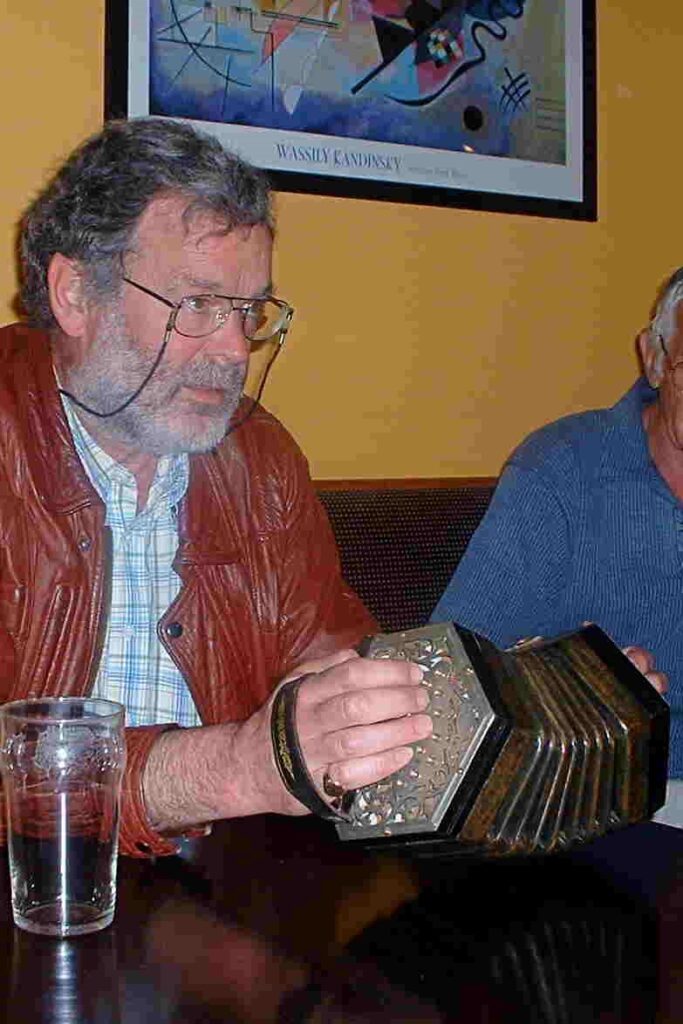
Fig. 5.The author with Kimber’s Anglo. Headington Quarry, 2005.
Scan Tester 11 (1887-1972), played for social dances and many of his polkas, waltzes and stepdance tunes are now session standards wherever English Country Music is played. He also busked, played on charabanc outings, and for well over thirty years played nearly every Saturday night in The Stone Quarry public house in Chelwood Gate. He was a multi-instrumentalist favouring the Anglo in his later years when arthritis prevented him playing the fiddle. Like most traditional musicians he drew tunes from a very wide range and his adoption of tunes from contemporary popular music doubtless proved useful when playing in pubs and busking. He stripped modern tunes down to their bare bones, usually abandoning accidentals and the ‘right’ chords very much in the way of jobbing pub piano players, and played them in his usual style as if they were dance tunes, which indeed they sometimes became.
Both these players were essentially dance musicians and both had as an element of their technique a way of playing which is often called ‘playing in octaves’. This involves playing the tune on the right and left hand simultaneously an octave apart. It is a technique also found in Ireland and Australia and in early published tutors. It has been suggested that this technique, doubling the volume of the tune, would have been useful when playing as a solo instrument for dancing. This theory has some validity, but my view is that in those circumstances it would have been even better to employ full rhythmic chords on the left hand, even at the risk of drowning the tune. I suspect the popularity of this technique may reside in the fact that it is musically straightforward as it requires just the ability to play the tune and does not require a knowledge of chord structure and chord selection. It is a very useful technique on which to build. Kimber regularly added the adjacent button to the one being played on the left hand, creating thirds and a very distinctive sound. Tester also underpins the octaves with bass notes.
With just these two examples before us 12 it is impossible to point to an English way of playing the Anglo, yet a further technique has taken root in England over the last half-century. Those of us who came to the Anglo in the 1970s, the time when a new level of attention was given to English Country Music, in the near total absence of recordings of Anglo players were, nevertheless, able to learn the musical styles from recordings of players of other instruments. This we then attempted to reproduce on the Anglo. In some ways we were mirroring what had happened a hundred years earlier when the German concertina arrived among rural musicians. 13
Before finding an Anglo Concertina I had been a guitarist and a fudging – not very good – piano player. I had come to think in terms of a melody line and a chord pattern, as found in busking books and this works nicely on the piano with a bit of practice with the left hand chords. On picking up an Anglo, I simply turned my wrists through 90 degrees and carried on.
The recordings of English Country Music which were at the time becoming widely available featured a number of melodeon players 14 and my approach mimicked the melodeon, with the tune on the right hand and chords on the left. This approach is found frequently in today’s English players and probably stems from transferring the melodeon approach to the Anglo. Yet, like octave playing, it is only a starting point. The Anglo allows a huge scope for playing those left hand chords, breaking them up, omitting thirds, adding bass runs and so on. John Watcham is an outstanding example of the variety that can be achieved.in this way 15.
Those reading this who, like me, remember the Folk Clubs of the 1960s will recall that in those days it was very unusual to see a concertina and then usually it was being used for song accompaniment, with the simple one line of the tune playing underneath the singing. This was easily achieved on Wheatstone’s English system, but to get a legato smoothness on the Anglo requires cross-rowing which in itself requires ingenuity, application and a lot of practice. Not surprisingly the easy option of the English system was favoured. 16
Today the Anglo is seen much more frequently than the English and this is the result of its use, and its appropriate driving sound, in the hands of players of English Country Music. Any English session is bound to contain at least one Anglo player, and often many. The high-quality instruments from the Victorian era, made by Wheatstone, Jeffries and Crabb as well as the top-end instruments of other makers emerged from junk shops and attics and proved to have many many more years of playing in them. Jeffries’ Anglos are now very highly regarded and command appropriately high prices. Their quality is remarkable and I’ve never seen one that was less than very good.
With the huge increase in Anglo playing there has been an equivalent increase in high quality musicianship and many players have developed distinctive playing techniques and adventurous repertories that astonish those who continue to think that the Anglo is an instrument for dance music only. There is no orthodoxy in how to play the Anglo in England. (Attempts to impose one in Ireland have made little headway.) Each player really is an individual making his or her way ahead through the many challenges and infinite options that exist. This is made increasingly individual by the fact that so many Anglos have different arrangements of notes outside the basic twenty buttons of the original German Concertina which always lie at the centre of every instrument.
For fifty years, one man has been the undisputed virtuoso of the Anglo Concertina – John Kirkpatrick. 17 John plays a Crabb concertina, a present from his parents, which is made to the Wheatstone forty button design. Among his many talents, John is a complete master of cross-rowing and this enables him to play in a number of keys and also to play any available note in any direction at any time – and, believe me, that is difficult! This complete mastery means that he can combine the smoothness of playing consecutive notes in the same bellows direction with the lift that comes from the bellows changes. Such is his skill that the demands of musical interpretation are never sacrificed to any easier fingerings.
It is appropriate that this brief essay on the Anglo should conclude with a few lines about one of the many players who demonstrate the remarkable versatility and scope of this wonderful, challenging instrument. 18
Roger Digby, July 2021
Footnotes
*1. I am grateful to Dan Worrall for reading a first version of this piece. Dan is a diligent researcher and prolific writer on, amongst other things, the Anglo Concertina. His three significant publications: on the instrument’s history, its use in house dances around the world, and the playing of William Kimber, are cited at points below. The improvements are his; the mistakes remain my own.
Dan’s major work, ‘The Anglo-German Concertina; A social History’ can be read online on Google Books.
2. It is very informative to consider why Uhlig chose to pitch the second row a fifth higher. If he had chosen to pitch it a semitone higher the instrument would have been fully chromatic, a forerunner of today’s button accordion. The ten new buttons gave twenty more notes, but only six were actually new. The other fourteen were duplicates of notes that were there already on the upper row, four in the same direction, ten in the reverse direction. Clearly Uhlig considered that the chromatic option was worth sacrificing to break the tyranny of in-out playing along the rows and to open up the cross-row opportunities.
3. Henry Mayhew, London Labour and the London Poor, vol 3, (1861). The whole interview was reprinted in PICA Vol 1 and can be read on the website of the International Concertina Association.
4. When I first visited my future in-laws in their cottage on the Welsh borders, I was amazed to see a German Concertina on the Welsh Dresser. Like the items that surrounded it, brass candlesticks, china jugs, pewter plates and stuffed animals, it was there for the very good reason that it always had been. There was no memory of who had owned it, or of it ever being played, though it was dusted daily. Some sense of atavistic awe had prolonged its life into the present day. It’s unplayable.
5. Generally, the shorter term ‘Anglo’ is applied today to all forms of the instrument.
6. The date for this is uncertain as there is a gap in the factory records. It was certainly after 1892. He held out for a long time!
7. For many many years Tony Engle drove this wonderful, committed record company into the byways of Traditional Music. Their contribution cannot be overestimated or overpraised. East Anglia is very well represented in their catalogue.
8. There are a few recordings of other Anglo players from this time, but they are hard to justify as traditional musicians.
9. So much has been written about Kimber that I will not add to it. The EFDSS has a CD issue ‘Absolutely Classic’ EFDSS CD 03 which has extensive notes. Dan Worrall, The Anglo Concertina Music of William Kimber, (2005) EFDSS, is the definitive study of his playing with transcriptions showing his fingerings and button selections. Professional studio recordings were made at HMV at various dates in the 1930s and 1940s. Again, information is easily available.
10. Lionel Bacon. A Handbook of Morris Dancing. (1974). The Morris Ring.
11. Scan Tester was not recorded commercially, but a number of friends and musical enthusiasts made personal recordings. A selection of these were eventually compiled in 1990 by Reg Hall, who knew Scan and who had made many of the recordings, on a double LP for Topic Records, later a double CD with extra tracks. ‘I Never Played to Many Posh Dances’, TSCD581D. To coincide with the original vinyl issue, Keith Summers at Musical Traditions published a monograph by the same name and written by Reg Hall which gave a full account of Tester’s life and music and the social setting in which both existed.
12. It is unrealistic to hope that any more recordings will be discovered, but it is occasionally possible to catch a glimpse of a small piece of the missing picture. Mark Bazeley, grandson of Bob Cann, (Cf. footnote 14) plays an Anglo that belonged to Bob. He recalls that when he played alongside his grandfather in The Dartmoor Pixies they would swap melodeon and Anglo between them. Mark started playing the Anglo for the step dancing competition in 1985; after about 26 years he handed the job to his nephew, Thomas White. On the LP sleeve mentioned below there is a picture of Bob’s Uncle George playing an Anglo for stepdancing in 1932 and the preference for the instrument for this task is affirmed by Lisa Sture who has researched stepdancing on Dartmoor and has references to the concertina being used for this as early as the 1880s. She mentions Les Rice, Jimmy Cooper and Nigel Sture as Anglo players for step dancing. I’m very grateful to Mark and Lisa for passing this information to me. (Mark is a fine player; hear him if you get the chance.)
13. Fortunately, without the hostility! A hundred years earlier there had been opposition to the introduction of a ‘foreign’ instrument; vid. Dan Worrall. House Dance. (2012) MTCD251 CD-ROM. (If you’re interested enough to be reading this article, you really should have this CD-ROM!!)
14. Two examples can suffice. English Country Music from East Anglia, (1973) 12TS229 features Oscar Woods (one-row melodeon) and Percy Brown (two-row melodeon). Bob Cann – West Country Melodeon, (1975) 12TS275 is totally given over to Bob Cann’s playing of a Hohner Club system. He was also a singer, stepdancer, storyteller, bandleader, caller…..
15. A recent publication, The Anglo Concertina Music of John Watcham (2020), Gary Coover, Rollston Press, gives detailed analysis of John Watcham’s playing.
16. One exception to this – as to nearly everything else – was Peter Bellamy, whose big left-hand chords, played with the buttons kept down through the bellows changes, was distinctive and instantly recognisable. Peter once admitted to me that he didn’t consider himself to be ‘a concertina player’, but that he could do what he needed and wanted. Fair enough! Requiesce in pace, Peter. We still miss you.
17. John has an excellent website. johnkirkpatrick.co.uk .
18. A 3-CD set Anglo International (2005) was issued by FolkSound Records FSCD 70. Its working title was ‘The Versatility of the Anglo’ and it sets out, successfully, to demonstrate just that. It is usually available from Amazon.
Roger Digby started playing the Anglo Concertina in the early 1970s. He has been an influential contributor to the English Country Music movement – in particular known to be a champion in the reawakening of interest and knowledge of rural English Dance music which had been neglected almost to extinction by the Folk Movement. He was one of the founders of the band Flowers and Frolics and currently plays in the Valiant Dance Band. You can read more about Roger and hear him at last.fm which you can access HERE.
